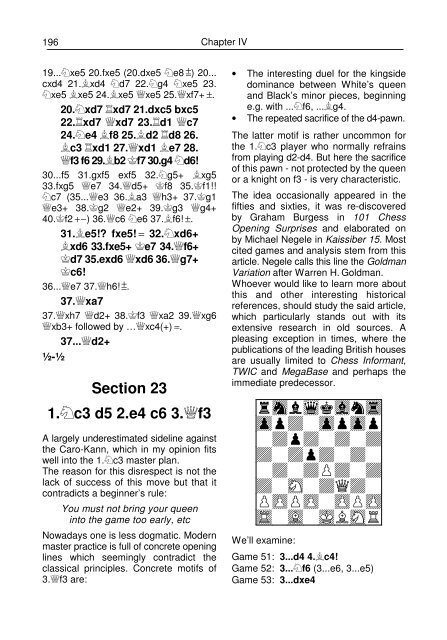Knight on the Left - Schachverlag Kania
Knight on the Left - Schachverlag Kania
Knight on the Left - Schachverlag Kania
Create successful ePaper yourself
Turn your PDF publications into a flip-book with our unique Google optimized e-Paper software.
196<br />
19... xe5 20.fxe5 (20.dxe5 e8 ) 20...<br />
cxd4 21. xd4 d7 22. g4 xe5 23.<br />
xe5 xe5 24. xe5 xe5 25. xf7+ .<br />
20. xd7 xd7 21.dxc5 bxc5<br />
22. xd7 xd7 23. d1 c7<br />
24. e4 f8 25. d2 d8 26.<br />
c3 xd1 27. xd1 e7 28.<br />
f3 f6 29. b2 f7 30.g4 d6!<br />
30...f5 31.gxf5 exf5 32. g5+ xg5<br />
33.fxg5 e7 34. d5+ f8 35. f1!!<br />
c7 (35... e3 36. a3 h3+ 37. g1<br />
e3+ 38. g2 e2+ 39. g3 g4+<br />
40. f2 ) 36. c6 e6 37. f6! .<br />
31. e5!? fxe5! 32. xd6+<br />
xd6 33.fxe5+ e7 34. f6+<br />
d7 35.exd6 xd6 36. g7+<br />
c6!<br />
36... e7 37. h6! .<br />
37. xa7<br />
37. xh7 d2+ 38. f3 xa2 39. xg6<br />
xb3+ followed by … xc4(+) .<br />
37... d2+<br />
½-½<br />
Secti<strong>on</strong> 23<br />
1. c3 d5 2.e4 c6 3. f3<br />
A largely underestimated sideline against<br />
<strong>the</strong> Caro-Kann, which in my opini<strong>on</strong> fits<br />
well into <strong>the</strong> 1. c3 master plan.<br />
The reas<strong>on</strong> for this disrespect is not <strong>the</strong><br />
lack of success of this move but that it<br />
c<strong>on</strong>tradicts a beginner’s rule:<br />
You must not bring your queen<br />
into <strong>the</strong> game too early, etc<br />
Nowadays <strong>on</strong>e is less dogmatic. Modern<br />
master practice is full of c<strong>on</strong>crete opening<br />
lines which seemingly c<strong>on</strong>tradict <strong>the</strong><br />
classical principles. C<strong>on</strong>crete motifs of<br />
3. f3 are:<br />
Chapter IV<br />
• The interesting duel for <strong>the</strong> kingside<br />
dominance between White’s queen<br />
and Black’s minor pieces, beginning<br />
e.g. with ... f6, ... g4.<br />
• The repeated sacrifice of <strong>the</strong> d4-pawn.<br />
The latter motif is ra<strong>the</strong>r uncomm<strong>on</strong> for<br />
<strong>the</strong> 1. c3 player who normally refrains<br />
from playing d2-d4. But here <strong>the</strong> sacrifice<br />
of this pawn - not protected by <strong>the</strong> queen<br />
or a knight <strong>on</strong> f3 - is very characteristic.<br />
The idea occasi<strong>on</strong>ally appeared in <strong>the</strong><br />
fifties and sixties, it was re-discovered<br />
by Graham Burgess in 101 Chess<br />
Opening Surprises and elaborated <strong>on</strong><br />
by Michael Negele in Kaissiber 15. Most<br />
cited games and analysis stem from this<br />
article. Negele calls this line <strong>the</strong> Goldman<br />
Variati<strong>on</strong> after Warren H. Goldman.<br />
Whoever would like to learn more about<br />
this and o<strong>the</strong>r interesting historical<br />
references, should study <strong>the</strong> said article,<br />
which particularly stands out with its<br />
extensive research in old sources. A<br />
pleasing excepti<strong>on</strong> in times, where <strong>the</strong><br />
publicati<strong>on</strong>s of <strong>the</strong> leading British houses<br />
are usually limited to Chess Informant,<br />
TWIC and MegaBase and perhaps <strong>the</strong><br />
immediate predecessor.<br />
We’ll examine:<br />
Game 51: 3...d4 4. c4!<br />
Game 52: 3... f6 (3...e6, 3...e5)<br />
Game 53: 3...dxe4



